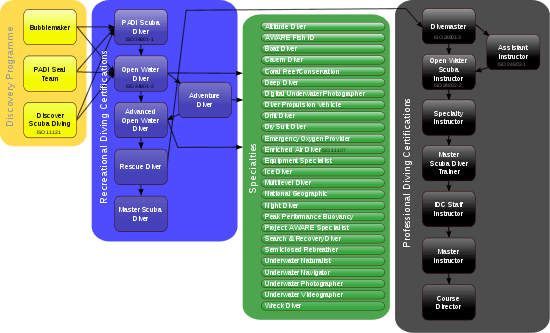Master Scuba Diver
Master Scuba Diver (MSD) is a scuba diving certification or recognition level offered by several North American diver training agencies, such as the National Association of Underwater Instructors (NAUI), the Professional Association of Diving Instructors (PADI), Scuba Diving International (SDI), and Scuba Schools International (SSI). Other agencies (e.g., The International Association of Nitrox and Technical Divers) offer similar programs under other names, such as "Elite Diver". Each of these (and other) agencies touts their program at this level as the highest, non-leadership program.
Most organizations have a minimum age requirement of 15 to undertake the Master Scuba Diver course, although some organizations do permit certification of "Junior" Master Scuba Divers.
Methodology
Different agencies take different approaches to this program creating both a disparate level of indicated diver competence both within most agencies as well as from agency to agency. The specific methodologies of the main agencies are as follows:
IANTD
IANTD awards their Elite Diver Recognition[1] to a diver who completes:
- IANTD Advanced Open Water Diver.
- Three IANTD specialties: Deep, EANx, Rescue and Navigation.
- Any two other IANTD specialties.
NAUI
The NAUI Master Scuba Diver course[2] is one of such courses offered by the major North American diver training organizations that is designed with both a skill based and academic core. The NAUI Master Scuba Diver course was specifically designed by two NAUI Instructors: Paul Heinmiller (NAUI 5141L) and Phil Sharkey (NAUI 4505L),[3] to meet a specific need that had been identified by the NAUI membership: a clearly defined course that provides, tests for, and certifies to, all the academic and skill training required of a NAUI Instructor, excepting topics covering teaching theory and methods and supervision of students and certified divers, topics that are part of NAUI's Divemaster and/or Instructor Training Course. The NAUI Master Scuba Diver course involves specific training in the theory and practice of:
- Emergency procedures and rescue
- Deep/simulated decompression diving
- Limited visibility or night diving
- Underwater navigation
- Search and recovery – light salvage
PADI

PADI awards their Master Scuba Diver Recognition[4] to a diver who completes:
- PADI Advanced Open Water Diver course or equivalent
- PADI Rescue Diver course
- EFR Emergency First Response course
- any Five different PADI specialty diving courses (not counting the Rescue Diver or EFR course)
- Logs 50 dives[5]
SDI
SDI awards their Master Scuba Diver Recognition[6] rating to a diver who completes:
- SDI Advanced Open Water Diver course
- SDI Rescue Diver course
- Completion of 4 SDI, TDI, or ERDI Specialty Courses or equivalent; only 1 course without dives, may be credited towards the master diver development program, with the exception of nitrox
- Logs 50 dives
SSI
SSI awards their Master Diver Recognition[7] to any diver who completes:
- any four different SSI Specialty Diving courses
- SSI Diver Stress & Rescue course
- Logs 50 dives
Footnotes
- "IANTD Elite Scuba Diver Recognition". IANTD. 2012. Retrieved 2012-06-05.
- "NAUI Master Diver Course". NAUI Worldwide. 2011. Archived from the original on 2012-02-16. Retrieved 2011-09-13.
- "History of NAUI" (PDF). Retrieved 2012-05-14.
- "PADI Master Scuba Diver Recognition". Professional Association of Diving Instructors. 2011. Retrieved 2011-09-13.
- "PADI Master Scuba Diver". Professional Association of Diving Instructors. 2014. Retrieved 2014-12-10.
- "SDI Master Scuba Diver Recognition". Scuba Diving International. 2011. Retrieved 2011-09-13.
- "SSI Master Diver Recognition". SSI Worldwide. 2011. Retrieved 2011-09-13.